“The voices of our ancestors can be recalled. It’s fruitful to listen.”
The Vraniak family’s land restoration shows how humans, wildlife, and land can sustain each other.
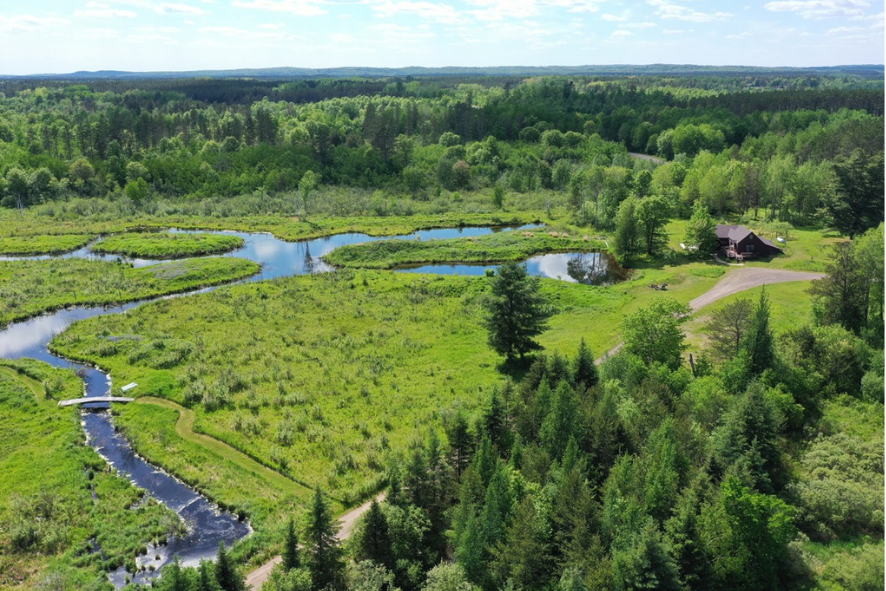
NRF member wants others to know that “it is helpful for private landowners and land managers to see what is possible, encouraging them to do their own efforts, where they are.” Photo by Damian Vraniak
Damian Vraniak’s 40-year restoration of his family’s prairie, savanna, and wetlands have been well worth it. In the first year of their wood turtle conservation work, they recorded less than 100 successful hatchlings — but in 2022, there were over 500!
Biodiversity has increased, and the people who have lived on the land throughout history have inspired many of the species he planted.
Vraniak spent critical portions of his childhood on the land with his Grandfather (Menominee, Hočąk (Ho-Chunk) and Scot), and his Grandmother (Anishinaabe (Ojibwe), Nakota (Assiniboine), Cree and French/Irish).
One of his great grandmother’s recipes for pemmican calls for saskatoon berries‚ so he planted saskatoon (serviceberry) trees. The heritage of all his grandmothers (and others who lived on the land over the years) then inspired the addition of native American Chestnut trees, an Irish potato garden, a group of Toggenburg goats, the introduction of Franklin ground squirrels, and more.
If you join him on one of the NRF Field Trips on his land this summer (#79-A and #79-B) you’ll identify native flowers and grasses, learn about turtle ecology (trips take place during nesting and hatching!) and become part of the history of this place yourself.
We just went about our restoration work, step by step, season by season. When you reach certain thresholds, everything just blooms and blossoms. You don’t realize all the things that you’ve done until you look back.


Wood turtle nesting in northern Wisconsin in 2017. Photo by Damian Vraniak
A conversation with Damian Vraniak
The Vraniak family’s relationship to their land
Shelly: Damian, what you’ve accomplished on your land is pretty impressive from an ecological restoration standpoint. But when we spoke on the phone, we ended up mostly talking about your family’s relationship with the land. Tell me more about how history and family inspire how you steward your land.
Damian: Let me give one brief example: In the 1600’s, my Huron great grandmother married the first Cadotte to come to the New World (the Cadottes were a well-known fur trader family in Northern Wisconsin). The “half-breed” children and mixed families were called Chicot or ‘half burnt stump children’ by the French, after their practice of cutting down trees to build a home and burning around the stumps to clear a plot for planting corn and other vegetables. This had been done by the Huron for generations, memorialized in the story of the Three Sisters – corn, squash and beans.
So, on my land, after I gradually thinned out the trees in one of our meadows leaving only stumps, I burned the brush piles around those stumps. My wife, children and I planted a three sisters’ garden in the fertile soil along the creek, amongst the stumps, in the same manner as my Huron ancestors had done among the oak savannas and my Chicot ancestors did along the St. Lawrence River nearly 500 years ago. It is March and we are still eating produce from that garden that we harvested last fall, stored in our downstairs root-cellar.
Now the French also used the word Chicot as their name for a certain rare tree. The Chicot tree, short with many branches, is poisonous to current wild animals. It was only recently discovered that the Chicot tree’s seeds were dispersed by mammoths historically, thus its current rarity. Indeed, one of the only remaining natural groves of the Chicot tree is on Wahpole Island First Nation Reserve in Canada, which has the only prairie that has been continuously burnt over the past thousand years or so. So near our prairie and savanna garden, we have planted Chicot trees.
Over time I have explored the lives of my grandparents’ grandparents, as a member of their seventh generation, in detailed fashion. In some cases, I have gone back another seven generations, into the 1600’s, to gain an even deeper understanding of my ancestors’ lives, what values they lived and what sustained their relations with the land and life with which/whom they lived.
In the past decade or two, as I have expanded the area of land I am restoring, I have examined the circumstances of the Indian and non-Indian landholders who temporarily occupied and/or owned portions of the land prior to my family’s stewardship. The purpose of reviewing prior landholders’ activities is to assess the beneficial and detrimental effects of their short ‘occupancy’ upon the land, waters, and wildlife.
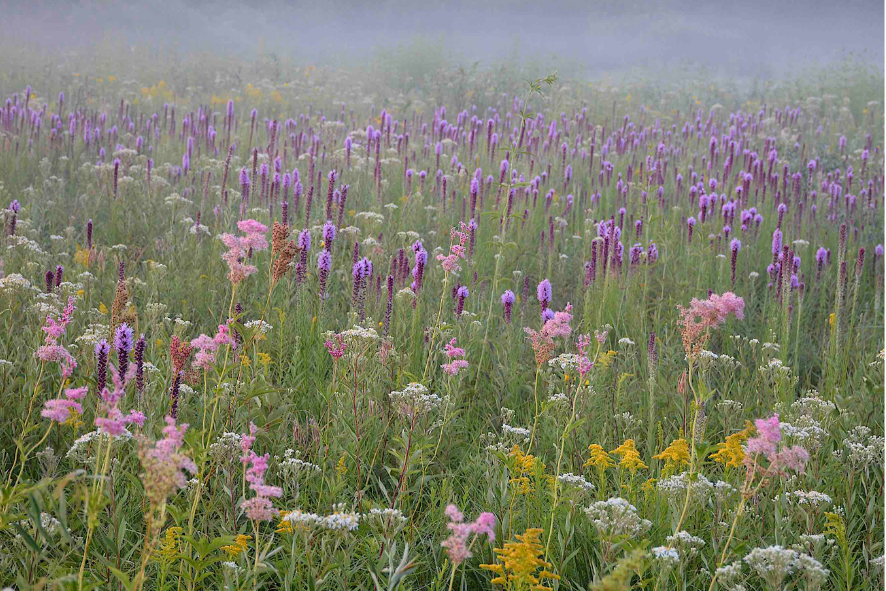
A prairie filled with wild flowers as fog sets in. Photo by Damian Vraniak
Growing a relationship with ecological restoration
Shelly: Working in conservation (and being a parent also), I think about future generations a lot. But I’ve never considered land use history in the very personal way you’re describing. The way the history of your family is touching the present makes it something that’s alive, now. But tell us about the beginning, back when you first started your land restoration in 1975. What advice would you give someone who’s just starting out with ecological restoration?
Damian: The beginning was with my grandmother. It was such a simple act, planting flowers with my grandmother when I was small. The sunlight fell softly on our shoulders and arms; the soil was warm to the touch. With the sun gently behind and above, the earth welcoming beneath and below, my grandmother kneeled next to me… we kneeled together, carefully parting the soil, gently placing the young plants and covering their roots. This seemed my first true prayer. I was too young to know about grace, but kneeling in the soil with my grandmother I learned deeply of comfort. The land is now and always a warm and welcoming hearth, and the memory of her kind and caring heart is comfort for me still.
That is where I would begin any effort at restoration, with the earliest memories you have and/or that you can find about your and your family’s engagement with the land.
Then, I would learn about the land, its soil, its water content, the plants and animals living on it currently, the seasonal weather, what access the plants have to sun in the spring, summer and fall, what plants are native and what might be invasive, before I tried to do anything.
When I started to actually do something, I would start very small – perhaps germinate a few seeds in pots in a bay window in February, ‘harden them off’ on the deck in May and transplant them at the beginning of June in a spot where I knew the plant could thrive.
Then, if I really liked what was happening I would commit myself for the next five+ years to read a lot about prairie restoration, take small steps that get a little larger each year, always watch and learn from what I had done, share what I was doing and the outcomes with someone who knew something more than I did, and with someone who knew less than I did (perhaps a child).
Always take photos as you go along, and always jot in a little journal about what you did, what happened and how you felt about it.
Probably the biggest mistake a person might make is to start really big and quit after a year or two. Doing restoration is much like raising a child, it does not end even when they hit twenty years of age, the relationship just changes and transforms itself as it matures.
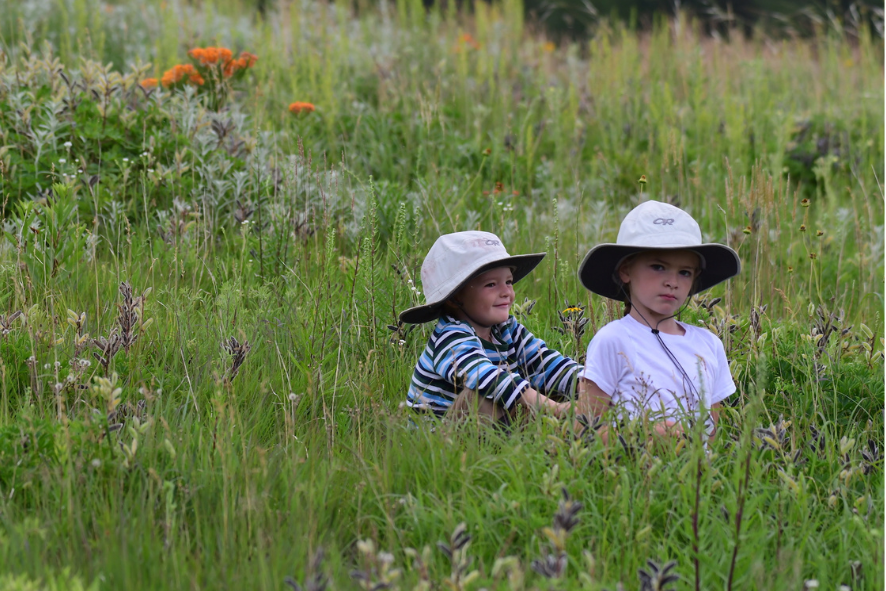
Damian Vraniak’s youngest sons sitting in the priarie. Photo by Damian Vraniak
The wolf and the rabbit
Shelly: You read me an excerpt from your book, about the wolf and the rabbit. Could you share that with me again, and with others reading this now? It might be helpful to those who are exploring the story of their own land – and what they want it to be.
Damian:
It is still, as the snow gently continues to fall. It is calm, for there is no wind to flurry the flakes about. It is quiet, as each unique crystal of white floats to its place among the others, ever so softly settling into interlaced oneness.
In the silence the white wolf is also still, calm and quiet … empty and open to whatever the Spirit-that-moves-through-all-beings will offer.
White upon white, he sees the cotton whiteness of the rabbit’s fur outlined sharply in the midst of the light subtly sparkling off the snow … and the dark eyes, full of fear. It is the time when stories come into being out of the pure whiteness, bursting, as the grouse now explodes between the wolf and the rabbit, startling both into motion. And so, it begins again – not one or two or three stories, but many stories surprising one another as they suddenly meet, as they always do, in the midst of other stories lying still and calm and quiet for a moment only, until all spring out of the crisp cold winter whiteness into surprising life, following, fleeing and flying in all directions, all at once. Who can see, who will hear, the stories lying under the hidden sky, under the crystalline snow, waiting, waiting to leap upward into being …
So it is that I am learning that the stories of how we come to love one another – or not, how we form, love and sustain our families – or not, are intimately linked, bound, to stories of how we beneficently care for the land, its waters and its life – or not.
Shelly: Thank you so much for taking the time to share your story with us, Damian.
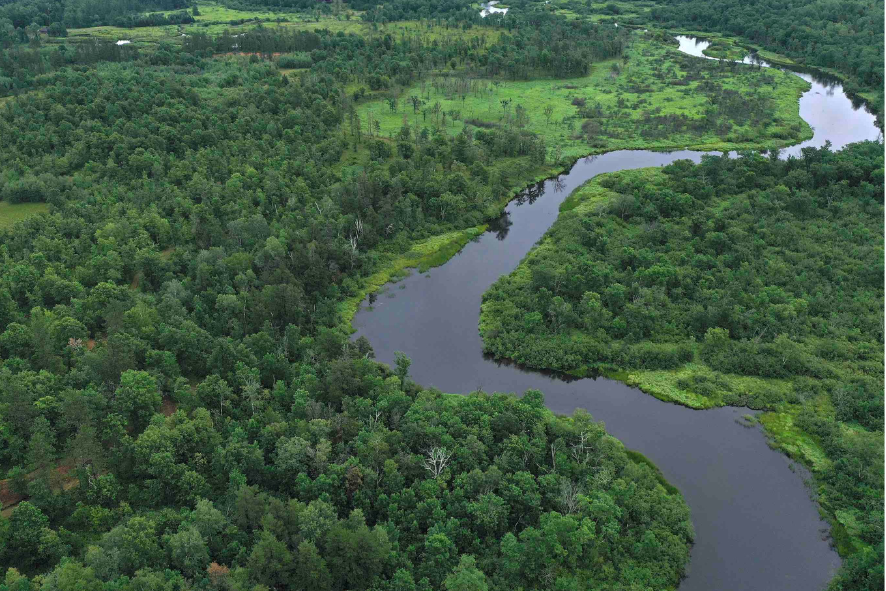
Drone shot of a winding river through a forest and prairie landscape – Damian Vraniak’s land. Photo by Damian Vraniak
What will be the story of your land?
If you own a wetland, forest, or prairie in Wisconsin, restoring your land can make an impact on the conservation landscape.. Learn more about the power of private lands and some resources that are available to landowners.
This year, we have a special selection of 22 Field Trips that showcase successful private land restoration and management. Look for the symbol below while you’re browsing our Field Trip Guidebook. Join us on one of these trips to learn from what other have done and get inspired.
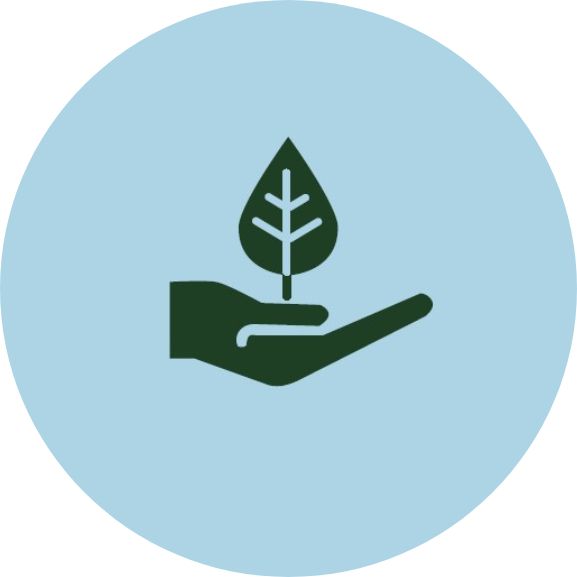
Several parts of this conversation are excerpts from Damian Vraniak’s writings, including Beyond the Seventh Generation: Listening to the Voices of our Ancestors as a Guide to Restoring Prairie & Savanna Landscapes and the upcoming The Wild Ways of Waters, Woods and Wives: A Cultural and Ecological History of the Vraniak Prairie & Savanna in Springbrook, Wisconsin (1650-1850, 1823-2023).
By Shelly Torkelson, Communications Director